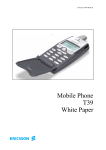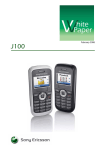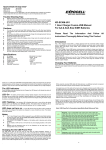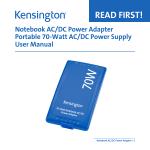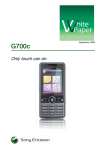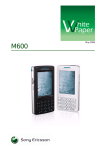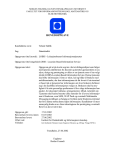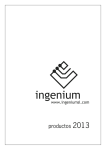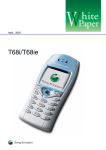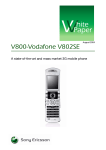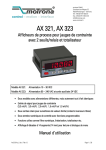Download Ericsson T20E Specifications
Transcript
EN/LZT 108 4803 R1A Mobile Phone T20e White Paper Ericsson is the leading provider in the new telecoms world, with communications solutions that combine telecom and datacom technologies with freedom of mobility for the user. With more than 100,000 employees in 140 countries, Ericsson simplifies communications for its customers - network operators, service providers, enterprises and consumers - the world over. First edition (March 2001) Publication number: EN/LZT 108 4803 R1A This document is published by Ericsson Mobile Communications AB, without any warranty. Improvements and changes to this text necessitated by typographical errors, inaccuracies of current information or improvements to programs and/or equipment, may be made by Ericsson Mobile Communications AB at any time and without notice. Such changes will, however, be incorporated into new editions of this document. Any hard copies of this document or any locally stored copies of this documents are to be regarded as temporary reference copies only. All rights reserved. © Ericsson Mobile Communications AB, 2001 Contents PREFACE . . . . . . . . . . . . . . . . . . . . . . . . . . . . . . . . 5 Purpose Of This Document . . . . . . . . . . . . . . . . . . . . . . . . . . . 5 PRODUCT OVERVIEW . . . . . . . . . . . . . . . . . . . . . 6 WAP SERVICES . . . . . . . . . . . . . . . . . . . . . . . . . . . 7 Using WAP In The T20e . . . . . . . . . . . . . . . . . . . . . . . . . . . . . 7 Bearer Type Characteristics. . . . . . . . . . . . . . . . . . . . . . . . . . . 8 Gateway Characteristics . . . . . . . . . . . . . . . . . . . . . . . . . . . . . 9 Connection-oriented And Connection-less WAP . . . . . . . . . . 9 Security Using WAP . . . . . . . . . . . . . . . . . . . . . . . . . . . . . . . . 9 Over-The-Air Provisioning Of WAP Settings. . . . . . . . . . . . 10 Configuration Of WAP Settings . . . . . . . . . . . . . . . . . . . . . . 10 POWERFUL MESSAGING AND CHAT . . . . . . . . 11 Enhanced Messaging Service (EMS) . . . . . . . . . . . . . . . . . . 11 Mobile Chat Via SMS . . . . . . . . . . . . . . . . . . . . . . . . . . . . . . 13 CONNECTIVITY . . . . . . . . . . . . . . . . . . . . . . . . . . 14 Infrared Modem . . . . . . . . . . . . . . . . . . . . . . . . . . . . . . . . . . . 14 Cable Connection. . . . . . . . . . . . . . . . . . . . . . . . . . . . . . . . . . 14 FUNCTIONS AND FEATURES . . . . . . . . . . . . . . 15 In-phone Functions And Features . . . . . . . . . . . . . . . . . . . . . 15 Network-Dependent Features . . . . . . . . . . . . . . . . . . . . . . . . 17 SIM APPLICATION TOOLKIT . . . . . . . . . . . . . . . 18 TERMINOLOGY AND ABBREVIATIONS . . . . . . 22 RELATED INFORMATION . . . . . . . . . . . . . . . . . . 25 APPENDIX: TECHNICAL SPECIFICATIONS . . . 26 3 4 PREFACE Purpose Of This Document The Ericsson T20e White Paper is designed to give the reader a deeper technical understanding of how the T20e is designed, and of how it interacts with other media. This document will make it easier to integrate the T20e with the IT and communications solutions of a company or organization. People who can benefit from this document include: • Corporate buyers • IT Professionals • Software developers • Support engineers • Business decision-makers The best place to find all the extras you need to support your phone and daily life is at the Ericsson Mobile Internet, http://mobileinternet.ericsson.com. Here you will find downloadable ring tones, games, news, information, and a host of exciting links to other sites. More information, useful for product, service and application developers, is published on the Ericsson Mobility World. The site at http://www.ericsson.com/mobilityworld contains upto-date information about technologies, products and tools. 5 PRODUCT OVERVIEW The T20e is a Dual Band phone with a lithium battery; a phone of modern design and advanced technology. • • • • • • • • • • • • It has a Wireless Application Protocol 1.1 (WAP 1.1) compliant browser, allowing fast and reliable access to Internet services with security according to WTLS class 2. Both access types, GSM Data and SMS, are supported. The T20e supports Enhanced Messaging Service (EMS), an enhancement of the SMS standard. This makes it possible to include pictures and melodies in messages, and also to receive and edit new pictures and melodies on the phone. Mobile chat over SMS provides Internet-style chat functionality. With the built-in Picture Editor and Melody Composer, users can create and editing their own pictures and melodies on the phone. Support for Swatch® Internet Time, a new global time concept, without time zones. It supports SIM Application Toolkit (Online Services), which makes it possible for operators to provide new services to existing users over the air, including new menus and functions in the phone. Profiles feature; groups of settings preset to suit certain environments, such as ”In Car”, ”Meeting”, ”Home”. A full graphic display with an easy to navigate, user interface software. Numbered shortcuts make it possible to prepare settings into a favourite menu which the user can access quickly and easily. The Mobile Office DI 28 infrared modem (optional accessory) turns the T20e into a wireless modem for data communication, Internet connection and fax from the user’s PC or PDA. The RS-232 cable DRS-10 (optional accessory) can be used for connecting the T20e to a PC. A wide range of accessories compatible with the T20e are available from your local Ericsson sales representative. 6 WAP SERVICES The typical WAP client is a small, portable device which is connected to a wireless network. This includes mobile phones, pagers, smart phones, PDAs and other small devices. In these devices, you have a limited user interface, low memory and computing power compared to desktop and laptop computers. The WAP browser in the T20e is compliant with WAP 1.1 including security according to WTLS class 2. It is designed for WML and cannot read ordinary HTML pages, but it is suitable for interaction with customer services, e. g. ticket reservation. It is also handy when you want to access text-based information, such as timetables, share prices and exchange rates and Internet banking and other interactive services. Using WAP In The T20e The built-in WAP browser gives the user portable, fast and secure access to a wide variety of services, with the possibility of personalized services. WAP in the T20e offers new opportunities to companies and service providers: Bearer types The T20e accesses WAP over a standard GSM Data connection as well as over SMS. (Network-dependent services.) Connection-oriented Connection-less or connection-oriented WAP can be selected by the user. Connection-oriented WAP provides browsing with a high reliability. Bandwidth efficiency One of the key advantages WAP has over text-based HTML pages on mobile devices, is the bandwidth efficiency for communication. This is due partly to the fact that the WAP application is communicated to the wireless devices in the form of binary encoded data. Provide settings Using SMS messages, configuration settings can be sent over the air, OTA, so that the user does not need to configure the WAP access settings manually. Creating WAP services Creating a WAP service is no harder than creating an Intranet/Internet service today since WML and WMLScript are based on well-known Internet technology. New market segments can be addressed by launching innovative mobile Value Added Services. Using standard tools It is possible for the service creator to use standard tools like ASP or CGI to generate content dynamically. You can utilize existing investments in databases etc. that are the basis of existing Internet services. Create a service once and make it accessible on a broad range of wireless networks. Maintain customer base You can adapt existing Internet services to WAP. The actual binary encoding can be handled by the WAP Gateway which makes it possible to create WAP applications using the text-based language WML and other tools. In fact, existing HTML-based applications on the Internet can be viewed in the WAP browser, if an automatic conversion is performed in the WAP Gateway. Improve productivity Improve and simplify the communication flow within an organization by making information available to mobile users. A company or organization can use a WAP gateway to provide a secure connection to the company network for their users. The WAP profiles The T20e holds several WAP profiles, each with a group of network settings and a home page. If you provide a corporate WAP service on your Intranet, it is useful to enter an Intranet WAP profile in user phones. The WAP profile holds network settings and user identification. The users switch easily between the corporate services and WAP services on the Internet, simply by switching WAP profile. 7 Bearer Type Characteristics The phone accesses WAP services over SMS or IP, where IP is provided over GSM Data. Typical differences which distinguish the bearer types are listed below this diagram. GSM Data Access • Circuit connection of data call means that the phone is connected during the WAP session. • Connection-oriented WAP (user option) uses error recovery services to provide high reliability. • Comparably higher transmission speed than with SMS access. • Pricing of GSM Data access can be compared to pricing of data calls in the network. • GSM Data is suitable for Complex Pull services, Browsing and Data transfer. • GSM Data is not suitable for Provisioning, Pager service. SMS Access • SMS point-to-point is used and not SMS Cell Broadcast. • The connection is maintained by the automatic exchange of ”messages” between the phone and the SMS Service Center. • Comparably lower transmission speed than with GSM Data access. • Pricing of SMS access can be compared to pricing of the normal SMS in the network. • SMS is suitable for Messaging services, Info services, Provisioning. • SMS is not suitable for Browsing or Data transfer. 8 Gateway Characteristics The WAP Gateway provides services in the company’s Intranet, a banking or stock trading service on the Internet, or access to other WAP applications on web addresses anywhere on the Internet. A Gateway is identified by an IP number or by a phone number, depending on access type. Connection-oriented And Connection-less WAP The T20e supports both connection-less and connection-oriented WAP over GSM Data. The user can select which method to use. In general, connection-oriented means that the connection between the WAP browser in the phone and the WAP Gateway is maintained in a session with error recovery services. This gives a high reliability with a reduced risk of errors in the transmission, and improves efficiency in WAP browsing. Security Using WAP The T20e is based on the WAP 1.1 specifications where security functionality is specified with a technology called Wireless Transport Layer Security (WTLS). The WAP protocols that handle the connection, its transport and its security are structured in protocol layers. The security is handled by the WTLS layer operating above the transport protocol layer. The WTLS layer is modular and there are WTLS classes that indicate which security level is supported by the application. • WTLS class 1 specifies an encoding of the information. • WTLS class 2 includes class 1 and in addition a server authentication, where server certificates are needed in the phone (access lock). • WTLS class 3 includes class 2 and in addition a client certification, where client certificates are needed for the user (signature lock). The T20e supports WTLS class 2, and it is equipped with a number of certificates. An access lock is needed when accessing certain WAP sites. The user is asked to enter it before a secure WAP connection is established. 9 Over-The-Air Provisioning Of WAP Settings To simplify configuring WAP settings in a number of phones, all settings can be sent as an SMS message to each phone. This makes it easy for an operator, a service provider or a company to distribute settings for Internet/Intranet, and WAP, without having to configure each phone manually. This also makes it easy to upgrade the services provided to the users, without the need for users to perform any manual configuration. • The OTA configuration message is distributed via SMS point-to-point • The setup information is a binary encoded XML message, according to WBXML. To receive information about OTA specifications, please contact your local Ericsson representative for consumer products. A configurator that utilizes OTA provisioning can be tested on the Ericsson Mobile Internet • The user is not alerted about new settings until the ongoing browsing session ends. Furthermore, settings are not changed during an ongoing browsing session • The necessary user interaction is limited to receiving and accepting/rejecting the configuration message, and selecting which WAP profile to allocate the settings to • Security can be handled using a keyword identifier displayed on the screen as a shared secret between the SMS sender and the receiver. It is important that the user has a way to verify that the configuration message is authentic Configuration Of WAP Settings To perform the WAP configuration of a single phone it is suggested to use the step-by-step WAP configurator provided on the Ericsson Mobile Internet. The configurator utilizes OTA provisioning, and it is available on http://mobileinternet.ericsson.com, no login required. The WAP settings can also be customized by the operator. A manual configuration is made using the menu system in the phone. This is described in the User’s Guide. 10 POWERFUL MESSAGING AND CHAT The T20e is capable of sending and receiving SMS messages, linked messages and it supports Enhanced Messaging Services (EMS). Also, mobile chat over SMS is supported. • With the Short Message Service, a user can send text messages containing up to 160 characters to and from GSM mobile stations (up to 70 characters using Chinese text) • With the linked SMS, the user can link several SMS messages together to create a longer message (network-dependent service) • With EMS, the T20e lets the user insert pictures and melodies, or ring tones, in outgoing messages. Also, the phone will display pictures and play melodies included in incoming messages (network-dependent service) • The T20e makes it possible to chat with a second party using SMS. The chat is a series of short messages and corresponding replies between the two parties, similar to chat services provided on the Internet. The T20e also lets you save often-used text messages as templates. You can save up to ten templates consisting of up to twenty-five characters each in the phone's memory. The T20e also features an SMS counter allowing you to keep track of SMS messages that you have sent. Enhanced Messaging Service (EMS) Enhanced Messaging Service (EMS) is a powerful enhancement of the SMS standard specified by the 3rd Generation Partnership Project (3GPP). It is supported by the major network operators and mobile phone manufacturers. With it, mobile phone users can add life to SMS text messaging in the form of pictures and melodies. This gives the users new ways to express feelings, moods and personality in SMS messages. Add life to messages to and from the T20e by inserting melodies. Users can express feelings and personality by inserting pictures in messages. As well as messaging, users will enjoy collecting and swapping pictures and ring signals and other melodies, downloading them from the Internet or editing them directly on the phone. See related documents listed under “Documents” on page 25. EMS is a network-dependent service. 11 Pictures In the T20e, there are more than 30 permanently stored pictures that express different moods and situations. The pictures are grouped by eight different themes to make them easy to find. In addition, the T20e has another 30 empty positions where the user can save pictures that have been received in incoming messages, or have been created by the user on the phone, see “Picture Editor” on page 12. Examples of pictures that can be pre-installed in the T20e For easy access, the user can save shortcuts to pre-installed or edited pictures in My Favourites, see the User’s Guide. Melodies Melodies received in incoming messages and composed by the user on the phone’s keypad can be stored in My Melodies. These are easily inserted in outgoing messages, see the User’s Guide. The built-in tool for editing and creating melodies on the phone’s keypad is the Melody Composer, see “Melody Composer” on page 15. Picture Editor The user can edit pictures and symbols directly on the phone, to create new, personal pictures for inclusion in EMS messages. The Picture Editor allows the user to view the picture in the display and to edit it with the pen tool. The available tools include: • Set line thickness • Zoom in, zoom out • Change picture width and height • Select black or white pen The T20e has a set of predefined pictures for use with EMS, which also can be edited. New pictures can be received with EMS messages and saved in the phone. See the User’s Guide for a description of this function. 12 Mobile Chat Via SMS The T20e makes it possible to chat with a second party using SMS. The chat is a series of short messages and corresponding replies between the two parties, similar to chat services provided on the Internet. This allows the user to review the conversation history in the display, and also to reply to messages by using a few commands. This makes the chat session quicker than using the current SMS feature. • Nicknames can be used to help identify the user in the chat. • Suspend chat session and resume. A user can temporarily leave a chat session, for example to use the calculator, or play a game, and then resume the chat session. • Automatic start-up of chat session from other Ericsson phones • Incoming and outgoing messages are identified with special icons in the display, and with the sender's nickname. • If the user is inactive for one hour the phone will ask if the user wants to continue the chat session. • The chat session can be saved as a history, for later review. 13 CONNECTIVITY The Mobile Office DI 28 infrared modem (optional accessory) turns the T20e into a wireless modem using AT commands. This provides data and e-mail communication, as well as Internet/ Intranet access, for a connected PC, PDA or handheld device. In the T20e, AT commands are used both for: • controlling the data communication between the PC and the remote service. This requires the Mobile Office DI 28 infrared modem (optional accessory). • configuring and requesting settings and behaviours in the phone, from a connected PC or PDA. This requires the Mobile Office DI 28 infrared modem (optional accessory), or the RS-232 cable DRS-10 (optional accessory). Infrared Modem When the Mobile Office DI 28 infrared modem (optional accessory) is connected, the T20e connects using infrared to a PC, a PDA, a laptop PC or another phone or mobile device. Infrared communication creates a data link between two communications devices through an infrared beam of light. Key benefits using T20e with the infrared modem: • True wireless communication • Low power consumption • Secure data transmission with the IrDA DATA standard • Send and receive e-mail and data on the connected PC/PDA • Connect to the Internet or Intranet/LAN from the connected PC/PDA By using Mobile Office DI 28, you can also manage the phone book, send SMS and personalize the start-up and shut-down shows. Please refer to further information about the Ericsson Mobile Office DI 28 infrared modem, available at http://www.ericsson.com. Cable Connection The RS-232 cable DRS-10 (optional accessory) makes it possible to connect the T20e to a PC or PDA. This provides access to configuration settings in the phone. Also, you can personalize the start-up and shut-down shows. Please refer to further information about the RS-232 cable DRS-10, available at http://www.ericsson.com. 14 FUNCTIONS AND FEATURES In-phone Functions And Features Melody Composer The T20e has a built-in Melody Composer, where the user can edit and create up to 8 melodies by using the phone’s keypad. Each melody can consist of up to 80 notes over 3 octaves. A note (or a rest) can be set in one of four durations. All this gives a great flexibility in creating personal ring tones and melodies for the user. Profiles The profile feature; group of settings preset to suit a certain environment. The profiles are also related to intelligent accessories such as a desktop charger, a portable or vehicle handsfree; useful for company integration with call forwarding etc. The easiest way to set up the profiles in one or several phones, is by using the Ericsson Phone Settings program, included in the Mobile Office DI 28 infrared modem (optional accessory). Internet Time Swatch® Internet Time represents a new global time concept, without time zones. The time is the same all over the world. The 24 hours of the day are divided into 1,000 “beats”. 1 beat is 1 minute 26.4 seconds. Internet Time is identified by @ plus three digits, ranging from @000 to @999. The Internet Day starts at midnight (wintertime) in Bienne, Switzerland, the home of Swatch (this means that Internet Time is equal to GMT +1). Internet Time was invented by Swatch Ltd. Internet Time can be switched on or off in the T20e. Conversion between local time and Internet Time is also supported. Voice Answering And Dialling The T20e supports voice answering and dialling, which makes it possible to interact with the phone using spoken commands. This is useful for handsfree use of the telephone. The functions include: • Voice dial - call someone by saying the name and number type, e.g “John, home” • Answer and reject calls with your voice when using a handsfree kit Phone Book In a company or an organization, you may need to deploy several phones with a common set of phone book entries. This is done in one of the following ways: • Use the Ericsson Phone Book and SMS Manager on your PC to prepare the common phone book entries. Then send the phone book entries from the PC to each and every phone. See the User’s Guide. or • Prepare the phone book on one SIM card in one phone. Copy the contents from this SIM card to the phone’s memory, then put each one of all the other SIM cards into the phone and copy the contents of the phone’s memory to them. See the User’s Guide. 15 Start-up And Shut-down Shows The T20e has built-in start-up and shut-down shows that feature a short animation with a melody. It is possible to create your own shows with a personal picture and melody. This option is called “My Animation”, and it can be managed in two ways: • Use the Mobile Office DI 28 infrared modem (optional accessory). The Phone Settings software includes a function that lets the user change the start-up and shut-down animation and install it on the T20e. or • Connect the phone to a PC using the RS-232 cable DRS-10 (optional accessory). The necessary program “My Animation” for personalizing the start-up and shut-down shows can be found on the Ericsson Mobile Internet. This is available on http://mobileinternet.ericsson.com. More In-phone Functions And Features • • • • Alphabet input (Arabic, Chinese, Cyrillic, Greek and Hebrew) Active Flip answering Alarm Automatic retry • • • • • • • • • • • • • • • • • • • • • • • • • • Background light Calculator Chinese text input (Stroke, Pinyin and Bopomofo) Clock Ericsson ring signal logotype External Antenna Connector Full graphic display 3 rows of text Games Helptexts and shortcuts Language selection Last dialled numbers Last received number redial Menu shortcuts Missed calls list Personal ring types Picture Editor Progress animation Received calls list Ring signal composition Screen saver Speed dialling Status view Stopwatch Timer Vibrating alert WAP browser and services 16 Network-Dependent Features Fixed Dialling And Restricted Calls For a company or an organization, it can be useful to restrict phone calls. Fixed Dialling allows you to preset a number of digits, for example area codes. This restricts the user to making calls only to numbers which use the preset digits as leading digits. Fixed Dialling makes use of the PIN2, and it requires fixed dial fields on the SIM Card. Check with your Operator about this feature. Restricted calls allows you to block outgoing or incoming calls in certain situations, for example international calls. More Network-dependent Features • Advice of Charge Charging • Advice of Charge Information • Automatic time zone • Call barring • Call forwarding • Call hold • Call screening • Call transfer • Call wait • Calling Line Identification CLI • Closed User Groups • Conference calls • EFR Enhanced Full Rate Speech Coding • e-GSM • Enhanced Messaging Service (EMS) • FR Full Rate Speech Coding • GSM 900/1800 Dual band • GSM phase 2+ • HR half rate speech coding • Home zone indication • International roaming • Mobile chat via SMS • Phone book on SIM • SIM Application Toolkit • SMS, concatenated SMS • Two line service / Alternate Line Service (ALS) • Voice mail • WAP 1.1 • WTLS class 2 17 SIM APPLICATION TOOLKIT The SIM Application Toolkit (SIM AT) is a smartcard-centric method of deploying programs that apply only to GSM and to SMS and USSD transports. Programs must be distributed on smartcards. WAP is an Internet-centric method of deploying programs that is independent of network technology. Programs and content are kept centrally on web servers and downloaded as required. While there is some overlap, WAP is a particularly good choice when deploying programs that also have an HTML version for desktop use. Work is currently underway on building interfaces between the two technologies. For an operator, a company or service provider, SIM AT offers a powerful way to deploy programs and services to users, without the need for new or upgraded equipment. All necessary setup and programming is distributed to the users over the air, directly to their phones. In the T20e, a separate menu is available for functions residing on the SIM card. These can include submenus for controlling functions, and also functions which allow the phone to initiate calls, send data, and display information for the user. SIM AT Services Supported By The T20e Service Mode Support in T20e CELL BROADCAST DOWNLOAD DISPLAY TEXT Yes bit 1: bit 8: GET INKEY 0 = normal priority Yes 1 = high priority Yes 0 = clear message after a delay Yes 1 = wait for user to clear message Yes General: The GET_INKEY requires that the user press “Yes” to confirm his/her choice Yes bit 1: 0 = digits (0-9, *, # and +) only Yes 1 = alphabet set Yes 0 = SMS default alphabet Yes 1 = UCS2 alphabet Yes 0 = character sets defined by bit 1 and bit 2 are enabled. No bit 2: bit 3: 1 = character sets defined by bit 1 and No bit 2 are disabled and the “Yes/No” response is requested. 18 Service Mode Support in T20e GET INPUT General: No of hidden input characters. 20 bit 1: 0 = digits (0-9, *, # and +) only Yes 1 = alphabet set Yes 0 = SMS default alphabet Yes 1 = UCS2 alphabet Yes 0 = ME may echo user input on the display Yes bit 2: bit 3: 1 = user input not to be revealed in any way (see note) bit 4: bit 8: 0 = user input to be in unpacked format Yes Yes 1 = user input to be in SMS packed format Yes 0 = no help information available Yes 1 = help information available No MORE TIME Yes POLLING OFF Yes POLL INTERVAL Yes PROVIDE LOCAL INFORMATION REFRESH '00' = Location Information (MCC, MNC, LAC and Cell Identity) Yes '01' = IMEI of the ME Yes '02' = Network Measurement results No '03' = Date, time and time zone $(DTTinPLI)$ No General: The reset option requests the user to turn off and turn on the mobile. Yes '00' =SIM Initialization and Full File Change Notification; Yes '01' = File Change Notification; Yes '02' = SIM Initialization and File Change Notification; Yes '03' = SIM Initialization; Yes '04' = SIM Reset; Yes SELECT ITEM SEND SHORT MESSAGE SEND SS Yes bit 1: 0 = packing not required Yes 1 = SMS packing by the ME required Yes Yes 19 Service Mode Support in T20e SET UP CALL General: Capability configuration Yes Setup speech call CallParty Subaddress DTMF support No Yes '00' = set up call, but only if not currently busy on another call; Yes '01' = set up call, but only if not currently busy on another call, with redial; Yes '02' = set up call, putting all other calls (if any) on hold; Yes '03' = set up call, putting all other calls (if any) on hold, with redial; Yes '04' = set up call, disconnecting all other calls (if any); Yes '05' = set up call, disconnecting all other calls (if any), with redial; Yes SET UP MENU Yes SMS PP DOWNLOAD Yes START MENU Yes User Interaction With SIM AT DISPLAY TEXT A text string of up to 160 characters (80 UCS coded) is supported. Text clearing times 10-20 seconds. 60-second timeout limit for the user to clear the text. ‘Key’ responses ‘Long NO’ – Proactive session terminated by user. ‘NO’ – Backward move in proactive session. Any other key clears display if the command is performed successfully. GET INKEY ‘Key’ responses Prompt for a one character input. Pressing ‘YES’ without entering a character gives warning message “Minimum 1 character”. ‘CLR’ clears current character. ‘Long NO’ terminates the proactive session. ‘NO’ – Backward move in proactive session. ‘YES’ – Command performed successfully. GET INPUT Prompt for character input. Pressing ‘YES’ without entering a character gives warning message “Minimum ‘no’ characters”. The phone will refuse to accept further input when maximum response length is exceeded. MMI Maximum Response lengths Digits Only – xx characters SMS default alphabet characters – 160 characters Hidden Characters (Digits Only) – 20 characters ‘Key’ responses ‘CLR’ clears current character/characters. ‘Long No’ terminates the proactive session ‘NO’ – Backward move in proactive session ‘YES’ – Command performed successfully 20 REFRESH A requirement to turn the phone off and then on again can be sent to the user with the text ‘Operator has updated your SIM! Restart phone to update!’. SELECT ITEM Scroll to highlight item for selection. The maximum number of items supported by the phone within one Select Item command, is 30. Down arrow – Scroll down list Up arrow – Scroll up list Long No’ terminates proactive session ‘NO’ – Backward move in proactive session ‘YES’ – Command performed successfully ‘Key’ responses SEND SHORT MESS. Default message “Sending message Please wait” can be replaced for the Alpha Identifier text, or suppressed completely if a null text is provided. Responses are “MESSAGE FAILED” or MESSAGE SENT”. ‘Key’ responses ‘Long No’ or ‘NO’ terminates the proactive session SET UP CALL If the ME is on a call when the command 'Set up Call, putting all other calls on hold' is sent, the user will see the text 'Setting up a call current call will be held'. If the 'YES' key is pressed the current call will be put on hold and the new call set up. If the ME is on a call when the command ‘Set Up Call, disconnecting all other calls’ is sent, the user will see the text ‘Setting up a call current call will be disconnected’. If the ‘YES’ key is pressed the current call will be disconnected and the new call set up. SET UP MENU Incorporates a SIM Application Toolkit Menu Item into the ME’s main menu structure. From the standby display the right or left arrow buttons can be pressed to select the Menu Items. (Note: The SIM AT menu option is found in the ‘Extras’ menu.) ‘Key’ responses If an Alpha Identifier is supplied in the Set Up Menu command this is used as the SIM AT entry in the ME’s main menu. If no alpha identifier is supplied and only one item provided, then this item is used as header. If no alpha identifier is supplied and several items are found in the menu, a default title is used. If the SIM AT Menu Item is selected using the ‘YES’ key all the items sent in the Set Up Menu command will be available for selection, in the same way as the Select Item command. A limit of 30 menu items has been set within this command. Down arrow – Scroll down list Up arrow – Scroll up list Side key: Scrolls the menu ‘YES’ – Envelope (Menu Selection) 21 TERMINOLOGY AND ABBREVIATIONS 3GPP 3rd Generation Partnership Project. API Application Programming Interface. Bearer The method for accessing WAP from the phone, for example GSM Data (CSD) and SMS. Bookmark A URL and header/title stored in the phone. Browsing session From the first access of content until the termination of the connection. Calling Line Identification (CLI) Shows the number of the person calling you in your mobile phone display. You can then make an informed choice as to whether or not to take the call. Bear in mind that not all numbers can be displayed. To use this service, it must be supported by your network. Card A single WML unit of navigation and user interface. May contain information to present to the user, instructions for gathering user input, etc. CGI Common Gateway Interface. CS Circuit Switched. CSD Circuit Switched Data. Deck A collection of WML cards. DTMF or Touch Tone Dual Tone Multi-Frequency signal – codes sent as tone signals. Used for telephone banking, accessing an answering machine, etc. e-GSM Extended GSM, e-GSM, are new frequencies specified by the European Radio communications Committee (ERC) for GSM use when additional spectrum is needed (Network-dependent). It allows operators to transmit and receive just outside GSM’s core 900 frequency band. This extension gives increased network capability, which favours both the user and the operators. EFR Enhanced Full Rate, speech coding. EMS Enhanced Messaging Service, an enhancement of the SMS standard. This makes it possible to include pictures, melodies, sounds and animations in messages, and also to receive and edit new pictures and melodies on the phone. ETSI European Telecommunications Standards Institute. FR Full Rate, speech coding. Gateway A WAP Gateway typically includes the following functions: - A Protocol Gateway – the protocol gateway translates requests from the WAP protocol stack to the WWW protocol stack (HTTP and TCP/ IP). - Content Encoders and Decoders – the content encoders translate Web content into compact encoded formats to reduce the size and number of packets traveling over the wireless data network. GIF Graphics Interchange Format. GSM Global System for Mobile Communications. GSM is the world’s most widely-used digital mobile phone system, now operating in over 100 countries around the world, particularly in Europe and Asia-Pacific. GSM 900 The GSM systems family includes GSM 900, GSM 1800 and GSM 1900. There are different phases of roll-out for the GSM system and 22 GSM phones are either phase 1 or phase 2 compliant. GSM 1800 Also known as DCS 1800 or PCN, this is a digital network working on a frequency of 1800 MHz. It is used in Europe and Asia-Pacific. HDML Handheld Device Markup Language. HDTP Handheld Device Transport Protocol. HR Half Rate, speech coding. HTML HyperText Markup Language. HTTP HyperText Transfer Protocol. Image WBMP or GIF image contained in a Card. iMelody The iMelody format, specified by IrDA, is a minimal set of tones that can be used in EMS applications to transfer melodies, such as ring tones, between devices. IrDA Infrared Data Association. ISP Internet Service Provider. ITTP Intelligent Terminal Transfer Protocol. LAN Local Area Network. ME Mobile Equipment. Micro browser Accesses and displays the Internet contents in your mobile phone, just as an ordinary browser does in your computer. The micro browser uses small file sizes and the bandwidth of the wireless-handheld network. MMI Man-machine interface. OTA Over-the Air Configuration. To provide settings for the phone by way of sending a message, SMS, over the network to the phone. This reduces the need for the user to configure the phone manually. PDA Personal Digital Assistant. Phone book A memory in your mobile phone or SIM card where phone numbers can be stored and accessed by name or position. PIM Personal Information Management. Service Provider A company that provides services and subscriptions to mobile phone users. SIM card Subscriber Identity Module card – a card that must be inserted in any GSM-based mobile phone. It contains subscriber details, security information and memory for a personal directory of numbers. The card can be a small plug-in type or credit card-sized but both types have the same functions. Your phone uses the small plug-in card. SMS Short Message Service. Allows messages of up to 160 characters to be sent and received via the network operator's message centre to your mobile phone. Messages are stored if the phone is off or out of reach ensuring that they reach you. To use this service, it must be supported by your network. SS Supplementary Services. TCP/IP Transmission Control Protocol/Internet Protocol. TE Terminal Equipment. TLS Transport Layer Security. URL Uniform Resource Locator. 23 USSD Unstructured Supplementary Services Data. VAD Voice Activated Dialling. VAS Value Added Service. WAE Wireless Application Environment. WAN Wide Area Network. WAP Wireless Application Protocol. Handheld devices, low bandwidth, binary coded, a deck/card metaphor to specify a service. A card is typically a unit of interaction with the user, that is, either presentation of information or request for information from the user. A collection of cards is called a deck, which usually constitutes a service. WAP Application A collection of WML cards, with the new context attribute set in the entry card. WAP service A WML application residing on a web site. WBMP WAP Bitmap. WDP Wireless Datagram Protocol. WML Wireless Markup Language. A markup language used for authoring services, fulfilling the same purpose as HyperText Markup Language (HTML) does on the World Wide Web (WWW). In contrast to HTML, WML is designed to fit small handheld devices. WMLScript WMLScript can be used to enhance the functionality of a service, just as for example JavaScript may be utilized in HTML. It makes it possible to add procedural logic and computational functions to WAP-based services, for example. WSP Wireless Session Protocol. WTLS Wireless Transport Layer Security. WWW World Wide Web. XML Extensible Markup Language. 24 RELATED INFORMATION Documents • The T20e User’s Guide • Mobile Phones R520, T20, A2628 Developers' Guidelines WAP Services • WAP 1.1 Specification • EMS specifications are found in “Technical Specification 3GPP; Technical realization of the Short Message Service (SMS)” (3G TS 23.040 V4.0.0 (2000-07)) • iMelody specifications are found in “Infrared Data Association; Specifications for Ir Mobile Communications (IrMC); iMelody (October 2000)” (Note that only a subset of this standard is supported) • Enhanced Messaging Service White Paper • Developers’ Guidelines for EMS • http://mobileinternet.ericsson.com - a site for the mobile phone user • http://www.ericsson.com/wap - a site for information on WAP • http://www.ericsson.com/mobilityworld - information, tools, white papers and software updates on Ericsson products and technologies; check frequently! • http://www.3gpp.org- home of the 3rd Generation Partnership Project • http://www.irda.org - home of the Infrared Data Association • http://www.etsi.org - home of the European Telecommunications Standards Institute • http://www.wapforum.org - home of the WAP Forum • http://www.swatch.ch - home of Swatch Ltd Links Trademarks And Acknowledgements W@ P™ and WAP Forum™ are registered trademarks of the WAP Forum, LTD., a registered company in the United Kingdom. Internet Time was invented by Swatch Ltd. Swatch is a registered trademark of Swatch Ltd. 25 APPENDIX: TECHNICAL SPECIFICATIONS The consumer pack includes 1 Mobile Phone T20e 1 Standard Battery BST 13 (1150 mAh) 1 Standard Charger CST-10 1 Carrying strap 1 Ericsson service and support leaflet 1 User’s Guide 1 Battery leaflet 1 Accessory leaflet General Product name System T20e/T20ec GSM phase 2 recommendations. GSM 900 (CTR 19 and CTR 20) and GSM 1800 (CTR 31 and CTR 32), e-GSM supported Speech coding HR, FR, EFR supported where available, for high speech quality SIM card Small plug-in card, 3V or 5V type Type number, T20e 1101 401-BV Type number, T20ec 1101 401-CN Exterior Description Size Weight Display size Graphic display Text rows Colours * Keypad 101 x 54 x 28 mm with kit battery approx. 128g 101 pixels wide, 33 pixels high black and white up to 3 rows of text Silver Weave, Lime Twist, Blue Whirl, Beige Harmony, Purple Wild 17 keys and a slider on the side Ambient Temperatures Operating Storage Charging Max: +55°C, Min -10°C Max: +70°C, Min -40°C Max: +35°C, Min 0°C Supported Man-Machine Interface (MMI) languages Depending on software in the phone, these languages are supported: Arabic (AR), Bulgarian (BG), Czech (CS), Chinese traditional (ZH), Chinese simplified (ZS), Chinese Taiwan (ZT), Croatian (HR), Danish (DA), Dutch (NL), English (EN), Estonian (ET), Farsi (FA)*, Finnish (FI), French (FR), German (DE), Greek (EL), Hebrew (IW), Hindi (HI)*, Hungarian (HU), Indonesian-Bahasar (IN), Italian (IT), Latin American Spanish (XL), Latvian (LV), Lithuanian (LT), Malay (MS), Norwegian (NO), Philippine-Tagalog (TL), Polish (PL), Portuguese (PT), Romanian (RO), Russian (RU), Serbian (SR), Slovakian (SK), Slovenian (SL), Sotho (ST), Spanish (ES), Swedish (SV), Thai (TH), Turkish (TR), Zulu (ZU), Vietnamese (VI) *) Some colours and languages may not be available at launch. 26 Performance And Technical Characteristics Dimension GSM 900/E-GSM 900 GSM 1800 Frequency range TX: 880 – 914 MHz RX: 925 – 959 MHz TX: 1710 – 1785 RX: 1805 – 1880 Channel spacing 200 kHz 200 kHz Number of channels 174 Carriers *8 (TDMA) 374 Carriers *8 (TDMA) Modulation GMSK GMSK TX Phase Accuracy < 5º RMS Phase error (burst) < 5º RMS Phase error (burst) Duplex spacing 45 MHz 95 MHz Frequency stability +/- 5 ppm (downlink RX) +/- 175 Hz (downlink RX) Voltage operation (nominal) 3.0 Volts 3.0 Volts Transmitter RF power output 33 dBm Class 4 (2W peak) 30 dBm Class 1 (1W peak) Transmitter Output impedance 50 Ω 50 Ω Transmitter Spurious emission < -36 dBm up to 1 GHz < -30 dBm over 1 GHz (according to GSM spec.) < - 30 dBm (according to GSM spec.) Receiver RF level Better than – 102 dBm -100 dBm Receiver RX Bit error rate < 2% < 2.43% *) No DTX activated 27 Current Consumptions, Talk And Standby Times Dimension GSM 900 GSM 1800 Transmission current 110 mA (min) 250 mA (max) 120 mA (min) 240 mA (max) Standby current 6 mA (min), (paging rate 9, 1 neighbour present) 6 mA (min), (paging rate 9, 1 neighbour present) 9 mA (max), (paging rate 2, 16 neighbours present) 9.5 mA (max), (paging rate 2, 15 neighbours present) Talk time 4 to 10 hours 4 to 10 hours Standby time 120 to 200 hours (up to 8 days) 120 to 200 hourss (up to 8 days) Dimension Full rate Enhanced full rate Type RPE/LPC with LTP ACELP Bit rate 13.0 Kbp/s 12.2 Kbp/s Frame duration 20 ms 20 ms Block length 260 bits 244 bits Class 1 bits 182 bits Class 2 bits 78 bits Speech Coding 28 WAP Browser Technical Data Feature Support in the T20e WAP browser Authentication WAP 1.1. Server applications may request Basic Authentication. Gateway may request Authentication during connection setup. Back to previous page Yes Bearer type GSMData (IP) Yes, ISDN and analog Bearer type SMS Yes (point-to-point) Bookmarks Yes, up to 25 named bookmarks for easy access to frequently visited pages Cache No Character sets * UTF8 (Default), USAASCII, Latin1, UCS2 Colour 1 bit (b/w) Home page Yes, up to 5 different, one for each WAP profile Hyperlinks in Text Yes, highlighted by inverse video Hyperlinks in Images Yes, indicated by a frame Image Animation No Image Formats GIF (interlaced and non-interlaced), WBMP, no transparent layers. Network Settings Up to 5 different settings available by selecting WAP profile (Intranet, Internet, Banking, Gateway etc) OTA Support Yes PPP Authentication PAP, CHAP and MS-CHAP Reload page Yes Tables Yes WAP/WML WAP 1.1 compliant, WMLScript Layers implemented: WAE, WSP, WDP WAP profiles 5 WAP profiles, each with its own settings WTLS (security) WTLS class 1 - Encoding WTLS class 2 - Encoding + Server Authentication. Root Certificates predefined in phone: Certicom, Verisign, Ensign (Entrust), Baltimore. More certificates will be supported in future revisions. *) When creating WML applications, it is recommended always to save the page contents as UTF8, and that this is clearly indicated in the pages before publishing. This ensures that the contents of the application can be viewed, regardless of character sets used in gateways and the phone. All characters are not supported in all phones. The software version depends on which market the phone is associated to. Also, please note that the phone may not support input on a WAP Service which uses certain characters (MMI languages), even if those characters are supported for browsing in the phone. 29 Enhanced Messaging Service Technical Data EMS Feature Support in T20e Concatenation (linked SMS) Yes, 3 parts, each message up to 128 bytes of data iMelody format support Note range: From octave 3 note c to octave 5 note b (Notes out of range are discarded) Durations: iMelody notation Example in Melody Composer 150 ms 0 c 225 ms 1 c. 300 ms 2 C 450 ms 3 C. Flat note: Yes, & ## Sharp note: Yes, # # Rest: Yes, r p Beat: No Style No, (S) Volume modifiers: No, (V+, V-) Volume: No, (V) Duration Specifier: No, (. : ;) Led: No Vibe: No Backlight: No Repeat: No Include melody in message Yes, according to iMelody v1.0 format Include picture in message Yes Melody composer Yes, up to 8 user defined melodies and ring tones in My Melodies, each melody up to 80 notes long. Four note durations available. Picture editor Yes, edit My Pictures in display using black or white pen, line thickness, zoom in, zoom out, picture size. Picture, pre-defined sizes Originated on phone (WxH in pixels): 16x16, 32x32 Received to phone (WxH in pixels): Small: 16x16, Large: 32x32 30 EMS Feature Support in T20e Picture, variable sizes Originated on phone (WxH in pixels): 8x8, 8x16, 8x32, 16x16, 16x32, 32x32 Received to phone: Width in pixels: (Pictures wider than display are truncated.) In multiples of 8 pixels up to the screen width (i.e. 8, 16, 24, 32, 40, 48, 56, 64, 72, 80, 88, 96) Height in pixels: from 1 to 1024. Note: The total product of Width and Height must never exceed 128 bytes. Play melody on focus Yes Pre-defined pictures Yes, grouped by themes Text templates Yes 31 32 Index Numerics 3GPP 11 A Abbreviations 22 Acknowledgement 25 B Bearer type characteristics 8 C Chat 13 Configuration of WAP 10 Connection-less WAP 9 Connection-oriented WAP Connectivity 14 9 D Documents 25 E Edit pictures 12 EMS 11 Enhanced Messaging Service 11 Enhanced Messaging Service Technical Data 30 F Fixed Dialling 17 Functions and features 15 G Gateway 9 GSM Data access characteristics GSM system support 26 8 I Internet time 15 L Languages, MMI Links 25 26 M Melodies 12 Melody 11 Melody composer 15 Mobile chat 13 My Animation 16 O Online Services 18 33 Over the Air provisioning 10 P Phone book 15 Pictures 12 Preface 5 Product description 6 Profiles 15 Purpose of this document 5 R Related information Restricted Calls 17 Ring tones 11 25 S Security using WAP 9 Shut-down show 16 SIM Application Toolkit 18 SIM card type 26 SMS 11 SMS access characteristics 8 Standby time 28 Start-up show 16 Supported MMI languages 26 T Talk time 28 Technical specifications 26 Terminology and abbreviations 22 Trademarks and acknowledgements 25 U User interaction with SIM AT 20 Using WAP in Ericsson T20e 7 W WAP configuration using PC WAP in Ericsson T20e 7 WAP services 7 Weight 26 10 34


































